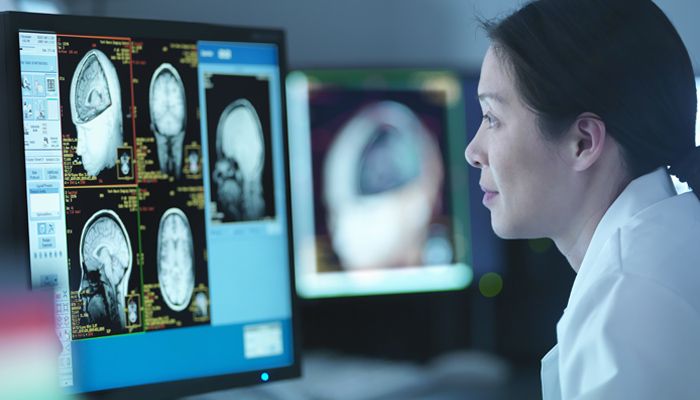If you’ve spent any time in and around healthcare facilities over the last few years, you’ve no doubt noticed that technology is everywhere. Human interactions between patients and practitioners are often complemented, or impeded, by the typing and screen tapping as your words are entered into a keyboard or a tablet.
Technology is also at the heart of inpatient and outpatient monitoring and tracking, from finding a hospital room for an incoming patient to moving patients around and between rooms and diagnostic treatment areas to keeping tabs on a heart monitor.
You know those 55-inch HD screens that track your airport departure and arrival times? Hospitals have them, too—monitoring patient vitals and locations on collective, quick-access nurses station data boards. What do all of these processes and tools have in common? Data. And data needs connectivity. If all these devices and people can’t talk to each other—and quickly—it’s all for naught.
The ascent of 5G is about to exponentially speed all of that data and open up lines of communication in brand new ways—both within and beyond the walls of the hospital. It will change how healthcare providers share critical information amongst themselves and between them and their patients—many of whom are currently left unserved solely on the basis of physical location. If everything goes to plan, high-speed networking will be pervasive and it’ll all be wireless.
5G—which is the next generation of networking that will not only supersede current 4G wireless standard as well as Ethernet and fiber—hangs its hat on speeding up communication channels in five areas:
- Enhanced mobile broadband (eMBB)
- Ultra-reliable low latency communications
- Massive machine-type communications/massive Internet of Things (MIoT)
- High reliability/availability
- Efficient energy usage
5G market potential
Currently, 5G has limited availability. As of a Viavi survey in January, 2020, it’s up and running in 378 cities across 34 countries, and 303 cities are in the top ten countries that have it. 57 of those are in China, 50 in the U.S., and 31 in the U.K. But whenever and wherever it expands, its widespread adoption will be a boon across multiple market areas, including healthcare, where, according to recent Accenture figures, it’s already being used in some fashion by 16 percent of providers.
IHS Markit projects that by 2035, 5G will support 22.3 million jobs and enable $13.2 trillion in global economic output, with a value chain generating $3.6 trillion in economic output. The global healthcare IoT market, which is projected to grow to $534.3 billion by 2025, will no doubt owe a significant amount of that trajectory to 5G connectivity.
What 5G means to healthcare
5G is expected to revolutionize the way healthcare providers talk to each other and their patients—from faster transit of testing and diagnostic results to telemedicine to remote monitoring and surgery, robotics, and more. The telemedicine market that’s running on current, pre-5G network backbones was already valued at $45 billion in 2019 and is expected to have 19.3 percent CAGR from 2020 to 2026.
Spring 2020 has given telemedicine its biggest test yet as people turned to it in droves to seek medical care while adhering to social distancing guidelines and stay-at-home orders. A recent survey by Sage Growth and Black Book Market Research found significant satisfaction—78 percent—in telehealth services. Forty-three percent said it was as effective as an office visit and 31 percent said it was better. And that’s with the fits, starts, and lags of non-5G. Imagine the improvement—and adoption rate—when 5G drives those engagements.
In addition to telehealth advancements, 5G presents an opportunity for healthcare providers to deliver high-speed, life-saving services beyond their physical walls. According to a recent Accenture study, 82 percent of healthcare executives agree 5G will revolutionize their industry by offering new ways to provide products and services.
Those include data benefits like transmitting massive digital diagnostic files such as MRI results without the latency issues of current wired and wireless communications. Early and current 5G use cases also include remote patient monitoring that allows hospital-based clinicians to deliver treatment guidance to remote areas and field workers.
When literally every moment matters to save a life, 5G can aid in real-time surgical procedures. Eventually, it’s projected to power remote surgery and treatment using robotics, and support augmented and virtual reality (AR/VR) and remote clinical care and wearables for mobile field support and telehealth. In those scenarios, highly-trained and experienced senior practitioners can lend their skills to remote and rural medical personnel from a single, centralized location.
Industry support for 5G
Dr. Shafiq Rab, chief information officer at Chicago’s Rush University System for Health, which is piloting the first 5G hospital in the U.S., shared his vision of what 5G could mean for enhanced, continuous patient care with Modern Healthcare. He foresees a nationwide 5G network that enables off-site monitoring so patients can go home faster and still receive top-tier care.
“When you go home, your connection back to the hospital…the doctor…the nurses does not stop,” he tells them. “Concurrent talking with five, seven, eight people together, your entire care team [online via video] becomes possible [with 5G].” Most people with a multi-doctor care team will tell you that’s not even an option now in an office setting.
The College of Healthcare Information Management Executives (CHIME), which represents over 2,800 chief information officers (CIOs) and other senior healthcare IT leaders, filed a statement on the importance of 5G for a U.S. Senate committee meeting last year. They laid out their support and vision of it delivering virtual patient care “anywhere at any time to anyone” while also “untethering expensive medical diagnostic equipment like x-ray and MRI imaging machines to make them mobile in the hospital environment.”
The group highlighted the importance of speed and data delivery for real-time care while also opening the door to the next evolution of imaging, diagnostics, data analytics, and treatments. “Faster speeds combined with cloud-based storage will enable advanced digital networks capable of generating and leveraging large quantities of data in ways previously unimaginable,” they said.
In a CHIME blog post, John S. Lee, MD, chief medical information officer (CMIO) at Edward-Elmhurst Healthcare, points to the behind-the-scenes benefits, too. “The gigabit speeds will allow for intense computing on edge. The combination of the cloud with edge computing [could] further blur the lines between local computation and cloud-based computation,” he says. “This concept then opens the possibility for high-bandwidth, high-demand computing without requiring providers on the clinical front lines to tether themselves to physical hardware.”
Security challenges
With IoT devices set to reap the benefits of 5G, the security, or lack thereof, around them, the network, and the apps they support will need to be addressed. As Patrick Filkins, senior research analyst of IoT and mobile network infrastructure at International Data Corp (IDC), tells TechRepublic and ZDNet, “[Inefficient] end-point security…can leave those end-points open to security breaches [putting] much of the security heavy lifting on network and IT resources positioned further away from end-points,” he says.
“As the network itself is upgraded to 5G, the need to upgrade network security will also be present…[to address the] greater potential for intrusions from inside the network or through ‘middle-man’ attacks.” He goes on to suggest taking, “a closer look at ways to incorporate security measures more tactically [and] at more layers than…in prior network generations. As more IoT applications are run on the network [hosted on-prem] or in an edge cloud, securing applications…will be at the forefront of 5G security concerns.”
Paul Bevan, research director for IT infrastructure at Bloor Research, adds that designing security into IoT devices and services is another way to address the security question. “This should be backed up by adherence to policies and an increasing use of artificial intelligence and machine learning to automate security operations,” he advises TechRepublic and ZDNet.
Some areas will have to wait for 5G
As with any new evolution of technology, the promises are many but the practicalities aren’t yet in place to deliver on them. While one of the boldest hopes for 5G is that it will be a great equalizer for healthcare delivery to rural areas, Glenn O’Donnell, vice president and research director at Forrester, says that’s still years away, at least in the U.S. “The FCC’s goal is to cover 90 percent of the population within five years. That’s absolutely not going to happen without substantial government subsidies,” he says.
“As a function of density, that 90 percent only covers 36 percent of the real estate in the U.S. Extending infrastructure to the boonies is extremely difficult, time-consuming, and expensive. Reaching the remaining 64 percent of the real estate with 5G will take well over a decade—if it happens at all.”
It’s about the data
Healthcare providers have become, much like every other industry, a data-driven business. The ability to move that data around, on the edge and the cloud, is of the utmost importance. In many instances, the lives of the patients they serve, a.k.a. their customers, depend on the ultra-fast, secure transmission of that data and ubiquitous access to people and resources. 5G stands to not only improve the customer experience from providers to patients and their families, but also to exponentially expand that experience to everyone within the healthcare system, too.
The Autonomous Digital Enterprise
These postings are my own and do not necessarily represent BMC's position, strategies, or opinion.
See an error or have a suggestion? Please let us know by emailing blogs@bmc.com.





